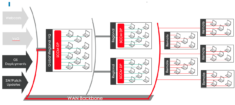When it comes to large, distributed enterprises like retailers or banks, every location has its own data challenges to overcome.
Tier 1 locations, like a global headquarters, can have thousands of employees in one building, while some large corporate campuses may serve 50,000 employees or more. That’s the equivalent of providing IT architecture for a small city, making IT more analogous to a utility than a corporate department. With a large number of employees comes the lion’s share of WAN bandwidth.
Tier 2 locations, on the other hand, get a medium amount of WAN bandwidth to work with. These regional offices can have hundreds of employees–enough to cause a crunch if everyone needs the network at once.
However, it’s at Tier 3 locations where things get dicey. These individual branches each contain a small staff relative to the overall enterprise, which means they only get a sliver of WAN bandwidth. There can be tens of thousands of these small and often remote offices spread throughout the country or even the world, and cumulatively they can require far more bandwidth than they are allotted.
In a traditional network architecture, distribution points are used to serve data to all three tiers. While Tier 1 and 2 may have on-premise distribution points and sufficient bandwidth necessary to keep data flowing, Tier 3 locations often find themselves at the short end of the data stick. That’s because those thousands of Tier 3 locations all have to battle to download data from the same limited, remote distribution points that are located back at a Tier 1 or 2 site. Here’s what that looks like in action:
What happens when all these remote offices try to download an OS deployment, a critical software patch, a live video town hall or on-demand training video from the same distribution point all at the same time? Data gets choked up in overloaded WAN gateways, causing video streams to buffer or fail and software patches from getting to all your endpoints.
While an enterprise can help alleviate the issue by deploying more distribution points, that can be an expensive and time-consuming proposition. The time and money it takes to design, implement, manage and maintain a hardware-based data distribution system can take up a significant portion of your IT budget and staff, leaving little left over of either to put towards more high-value initiatives. Distribution points simply aren’t scalable for the needs of a fast-growing enterprise.
Alternatively, by using a software-based enterprise content delivery network like Kollective you can scale your distribution network in a way that makes sense for both your major Tier 1 and 2 offices and your many Tier 3 locations. By using a peering architecture, endpoints within a location can download data from each other, rather than clogging up the network downloading the same file from a remote distribution point. The result is a 99% reduction in WAN bandwidth, not to mention faster and more reliable delivery of things like live video streams and software patches to even your most remote offices. Here’s the same data as before as delivered via Kollective’s ECDN.
This is a far more effective and efficient way of delivering data. It also allows you to eliminate or redeploy up to 90% of your physical distribution point infrastructure, reducing hardware costs while freeing up IT staff time for more strategic initiatives. Unlike a distribution point-based model, Kollective IQ, Kollective’s analytics platform provides the metrics you need to understand network performance, track the success of your content, and even see precisely who watched a video or which endpoints still require a software patch update.
The great promise of enterprise video and software innovations like Microsoft 365 is improved collaboration. By replacing distribution points with a software-based solution, you can remove a significant obstacle to the flow of data, allowing global headquarters and remote locations alike to work more closely together.
ONE PLATFORM, MULTIPLE SOLUTIONS
Solve the most complex network traffic problems with a single platform that enables you to deliver Live Video, VOD, and Software Updates – with efficiency and ease.
Related Blog Posts
5 Ways Your Enterprise Company Could Benefit from Video All-Hands Meetings
Town hall meetings. Round-ups. All-hands meetings. Whatever your company calls it, most businesses have some iteration of the all-hands meeting, which exists to keep employees at all levels in the loop on current initiatives, progress, growth and company news. These…
Are Distribution Points Holding Your Remote Offices Back?
When it comes to large, distributed enterprises like retailers or banks, every location has its own data challenges to overcome. Tier 1 locations, like a global headquarters, can have thousands of employees in one building, while some large corporate campuses may…
3 Roadblocks Keeping You From Corporate Video Success
When it comes to enterprise video, internal communications teams always begin with the best of intentions. They envision live video being used to connect corporate leaders with offices around the world so the CEO can deliver her vision live instead over email. Or…
The post Are Distribution Points Holding Your Remote Offices Back? appeared first on Kollective Technology .






